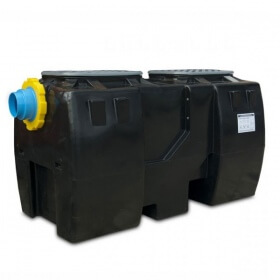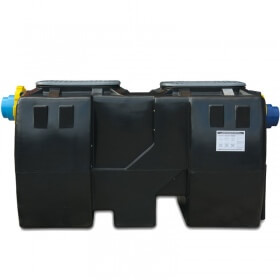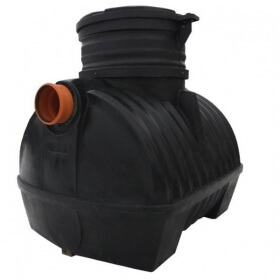- favorite 8 likes
- remove_red_eye 36362 views
- comment 3 comments

Choosing a separator for a car wash
In our country, the ecological awareness is growing, so we are more often aware of the threat posed by the discharge of polluted sewage into the environment. More attention is paid to the condition of rainwater and sanitary sewage discharged to sewage systems, natural receivers, surface and underground waters.
Legal requirements for separators
Pursuant to the Regulation of the Minister of Infrastructure of July 20 2002, we are obliged to treat rainwater and process sewage discharged from, among others, polluted city centers, gas stations or car washes. Pursuant to the Act, in the wastewater discharged to natural reservoirs and municipal sewage system, the content of suspended solids at the outflow should not exceed 100 mg / l, and the content of petroleum substances cannot exceed 15 mg / l. It is impossible to obtain sewage that meets these parameters in car washes. It is necessary to use oil derivative separators to clean the sewage before discharging it into the sewage system. Fully retention separators are dedicated to car washes because they clean the entire flow that can be discharged to the sewage system. Fully retention devices are used in places where there is a high risk of contamination.
How does the oil substances separator work?
The oil substances separator is a sanitary installation device whose task is to purify water from hydrocarbon contamination. Separators purify technological wastewater that comes, for example, from car washes, workshops, and vehicle storage. In the oil derivative substances separator, the supplied sewage is cleaned of petroleum substances and solid impurities (e.g. sand, earth, gravel, etc.). The first stage of wastewater treatment consists in separating solid pollutants with the help of a settling tank (so-called sand trap) in the process of gravitational sedimentation. Separators with an enlarged sedimentation tank are dedicated to car washes due to the greater amount of mineral sediment (sand, stones, etc.). In the second phase, the wastewater flows into the separation chamber, where, with the help of special filters, the separation and then collection of petroleum particles takes place. In this phase, contaminated water flows through a special coalescing or lamella filter, which is designed to facilitate the flow of petroleum substances to the surface, where the separated particles clump into larger clusters, creating a layer of petroleum substances. In the third stage, i.e. the last stage of treatment, the sewage flows out of the device through the drain to the sewage system. The outflow is equipped with an automatic float closure which closes the tank when it is overfilled with accumulated petroleum substances.
Car wash - sewage disposal process
In car washes, heavily contaminated sewage with petroleum substances such as gasoline, oil or grease cannot be discharged directly to sewage systems. Oil substances separators are used to protect sewage systems and reservoirs against oils included in sewage. They retain environmentally hazardous substances in the discharged sewage, and the pre-treated water can be further discharged into the sewage system or a drainless reservoir. In car washes, the technological flow is forced by pressure washers, the sum of the flows of which will allow us to design a separator with an appropriate flow. It is also worth paying attention to whether the car wash will be roofed, otherwise additional calculations of the open area collecting rainwater should be made. The drainage line of the washing station must first have a drainage grille, then a sand trap and a fully flow class I oil separator. 1.5 l / s of flow is assumed for one car wash station (of course, it is better to check the efficiency of a pressure washer).
Car washes also use systems for recycling pre-treated water. The closed water circulation system (called: "ZOW") in vehicle washing plants purifies sewage to such an extent that the reclaimed water can be used repeatedly. Closed-loop treatment uses the known technology, namely:
- sedimentation and gravity de-oiling in a horizontal flow settling tank - first stage of treatment,
- sedimentation and chemically assisted deoiling (flocculation) in a multi-stream package - second stage of treatment,
- filtration and sorption on a filter with an adsorption bed (granulated diatomite) - the third stage of purification.
In European countries, closed water circulation are used more and more in car washes. There is usually no such installation in Poland. One of the reasons is the relatively low cost of water and the low (if any) sewage disposal charges. Additionally, the high investment cost makes installing ZOW systems an expensive undertaking for the car wash owner.

Kinds and types of oil substances separators
There are many separator solutions on the market today. The Polish standard PN-EN 858: 2005 divides separators into two categories, class I and class II. Some of the separators are made of polyethylene, which affects the service life of the installation and ease of maintenance, and some - reinforced concrete. For car washes, fully retention separators are installed, which means full flow through the separation chamber, while for parking lots and outdoor areas, a separator with a hydraulic bypass can be used due to the higher flows caused by torrential rain (increased long-term rainfall). The solutions are also divided into the method of filtration (coalescing insert, lamella insert). Below we present the development of the issues:
• Class I purification separator - designed to achieve a concentration below 5 mg / l of oil at the outlet under standard test conditions. Class I includes coalescence and lamella separators.
• Class II purification separator - designed to achieve a concentration below 100mg / l of oil at the outlet under standard test conditions. Class II includes separators mainly using mechanical separation (sedimentation and flotation).
• Separator with a sedimentation tank - in this device, the process of sedimentation of larger mineral impurities, i.e. sand, silt, stones, takes place additionally. The sedimentation tank is designed to additionally protect the installation against clogging. Separators with an enlarged sedimentation tank are dedicated to car washes, catch large amounts of mud and sand, which guarantee safe operation of the device.
• Separator with a pump chamber - is used when it is impossible to discharge treated sewage by gravity. Pumps pump the treated sewage to the place of its discharge to the gravity sewage system.
• Coalescence cartridge separator - the basic physical process in this separator is coalescence-assisted flotation, i.e. combining small oil particles dispersed in water into larger clusters, which allows for more effective flotation of pollutants. Depending on the type of the separator, the coalescence takes place on a properly selected type of filter.
• Separator with lamella insert - the process of dirt separation takes place thanks to the use of multi-stream technology by carrying sewage through a specially constructed filtering cabinet consisting of removable lamella sections. During the flow, fine oil particles carried by the liquid are deposited on the underside of the lamella plates. After reaching certain values, the separated oil particles, due to the buoyancy forces, float up along the bottom side of the plate, forming an oil layer on the surface.
• Separator with a bypass - additionally equipped with a workaround with a flow greater than the nominal flow. A workaround is a safety solution in the event of excessive waste. The separator is most often used for rainwater treatment in parking lots or vehicle disassembly yards.
Separators can be equipped with additional accessories, e.g. signaling devices and monitoring sensors. The proposed alarm systems guarantee the safety of the environment, ensure the comfort of supervision and reduce operating costs. The petroleum substances signalling unit can be connected to max. 3 sensors located inside the separator, thus enabling: overfilling control, sludge level, monitoring of the thickness of the contamination layer. The siren acoustically informs about emergency situations. Additionally, it is equipped with LED diodes that indicate the current operating status of the separator.
Selection of oil substances separators for car washes - calculations
The selection of a separator for a car wash is made by counting the flows of washers that will create the maximum water flow in accordance with PN-EN 858: 2005
General formula for selecting separators according to PN_EN 858: 2005
NS=(Qr + fx ∙ Qs) ∙ fd
where:
NS - flow rate,
Qr - nominal flow of rainwater in l / s,
Qs - maximum flow of process wastewater in l / s,
Fd - density coefficient (usually we take the value 1),
fx - separation difficulty factor (usually we take the value 1).
Calculation of the volume of process wastewater (e.g. car washes and the amount of flows generated by high-pressure washers)
QS=QS1 + QS2 + QS3 +…
where:
QS1 - wastewater from draw points (table 1.),
QS2 - sewage from car washes and / or self-service washing stands (check washer flow),
QS3 - wastewater from high-pressure cleaners and cleaning units.
Table 1 The volume of wastewater produced from the intake points depending on the valve diameter
| Nominal diameter | Number of intakes points | ||||
| Expenditure Qr in l/s | |||||
| 1 valve | 2 valves | 3 valves | 4 valves | 7 valves | |
| DN 15 R 1/2'' | 0,5 | 1,00 | 1,50 | 2,00 | 3,00 |
| DN 20 R 3/4'' | 1,00 | 2,00 | 3,00 | 4,00 | 6,00 |
| DN 25 R 1/0'' | 1,70 | 3,50 | 5,00 | 7,00 | 10,00 |
Qs2 I Qs3 - Car washes - 3l / s should be used for each car wash, and 1l / s of sewage for each subsequent station, unless the flows in the washers are much higher.
Calculation example
Below is an example of selecting a separator for a self-service three-stand car wash:
• Nominal flow of rainwater: 0 l/s,
• Max flow of process wastewater: 6 l/s,
• Density factor: 1,
• Separation difficulty factor: 1.
Ns= (0+6+1)·1=7
Selection summary
For a self-service three-station car wash, the instantaneous flow will be 7 l / s. The separator for this car wash should have an enlarged sedimentation tank chamber and the flow of not less than 7l / s. Too low flow makes it impossible to achieve the correct parameters of process wastewater treatment, while too high is unprofitable from an economic point of view.
Maintenance
According to Regulations of the ordinance of the Minister of Environmental Protection of Natural Resources and Forestry (MOŚZNiL) of December 24, 1997, Journal Of Laws No. 162, item 1135 petroleum substances are classified as hazardous substances. Maintenance and servicing of separators must be carried out by a qualified company that has a permit for the transport and management of hazardous waste. Inspections of petroleum separators consist of periodic emptying of waste retained in the device and cleaning the inside of the separator. The periodicity of cleaning depends on the rate of waste accumulation (at least once a year). Cleaning should be carried out when the tank is full of sediments to half its volume or in 4/5 of the maximum oil holding capacity. After cleaning, fill the separator with water and set the float valve to its working position.
Currently, there is a wide range of different oil separators on the market. Before buying a separator, we should consult with the designer to properly select the separator for our needs. Only a properly selected and used separator will properly fulfill its function and protect the environment for many years.
Related products
Fuel substances separator OIL 2LS I with desilter
- The separator of petroleum substances
- Increased settler twice
- Coalescence or lamellae insert
Fuel substances separator OIL 3LS I with desilter
- The separator of petroleum substances
- Increased settler three times
- Coalescence or lamellae insert
Fuel substances separator with desilter OIL-SI
- Fuel substances separator
- Integrated settler
- Flow of 1,5 l/s to 25 l/s
SWK oil/water separator
- Petroleum-based substances separator
- Suitable for small factories, workshops, car washes
- Flow rate from 1.5 to 10 l/s
Comments (3)
-
Czy mogę kupić
-
is there a Separator with a pump chamber and with a bypass for rate flow 25 l/s. kindly provide catalogue and photos
-
Please email all questions about products to: kontakt@aquatechnika.com.pl




